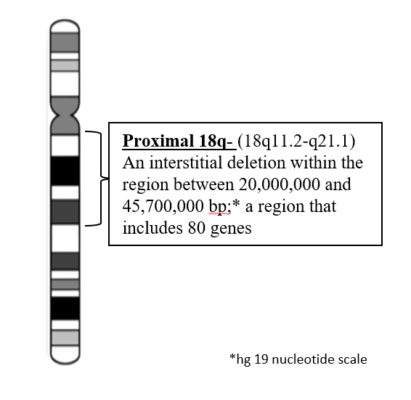Proximal 18q- Treatment and Surveillance
 ICD-10 = Q99.9 or Q93.89
ICD-10 = Q99.9 or Q93.89
These recommendations are inclusive of the entire population of people with Proximal 18q deletions even though each person has a unique deletion. Therefore each person’s deletion could have different genes that are hemizygous. The specific hemizygous genes for an individual patient will dictate the probability of particular phenotypes. Guidance for creating an individualized plan for evaluation and management based on the person’s specific deletion can be found in the next section. However, the information in this document encompasses the global proximal 18q- evaluation and management plan.
Potential conditions in a neonate
- Structural
- Palate abnormality
- Functional
- Respiratory
- Feeding difficulties
- Central apnea
- Hypotonia
- Biochemical
- Jaundice
Initial evaluations after diagnosis
- Cardiology evaluation – 50% have cardiac defects
- Hearing evaluation – 30% with hearing deficits
- Renal ultrasound – 43% with reflux
- Vision evaluation – 64% with optic problems
- MRI- 62% abnormal findings
Referrals to
- Appropriate sub-specialist as indicated by initial evaluations
- Genetics Follow-up
- Parents genotyped for balanced rearrangements
- Early intervention/developmental services
- The Chromosome 18 Registry & Research Society
- The Chromosome 18 Clinical Research Center
Closely monitor and manage
- Failure to thrive/ growth failure
- Weight gain
- Linear growth
- Sinus/ ear infections
- Genitourinary
- Reflux
- Gastrointestinal
- Immunology/Rheumatology
- Atopic disorders
- Orthopedics
- Scoliosis
- Respiratory issues
- Neurology
- Seizure disorder
- Tremors
- Hypotonia
- Development
- Milestones
- Psychometric data
Annual Screenings
- Vision
- Hearing
Current Adult Status
Age and Cause of Death
There is additional information on each of the areas mentioned above within the downloadable PDF document.
Updated 2020

